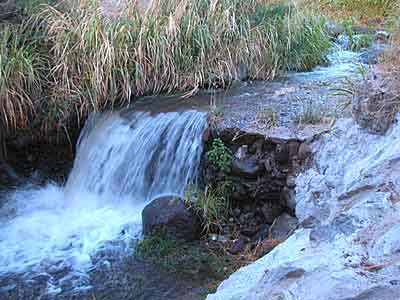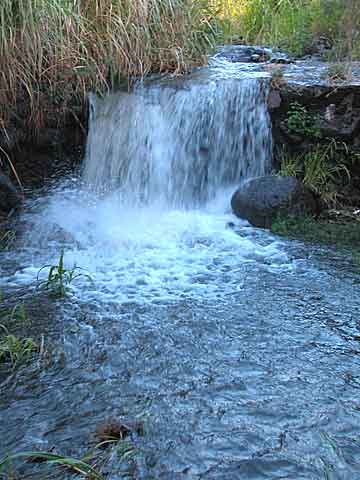Surplus water regularly ends up being "dumped"
October 22, 2004
Ed Lindsey and Lucienne de Naie
for Maui Tomorrow
 |
|
Pictured is unneeded (wasted) water from Waihe’e ditch as viewed today
(October 22, 2004) from Honoapiilani Hiway at Pohakea bridge in
Waikapu, Maui. This flow is not the result of rainy runoff. Rather it
is the result of overflowing ditches and reservoirs in the Wailuku
Ag/HC&S system that continue to receive a combined total of up to
40 mgd of stream water that was once necessary to irrigate thousands of
acres of ag fields.
While most of the vast pineapple, cane and mac nut fields this water
once irrigated now lie dormant, the ditch flows have not been reduced
(except when extremely dry weather lowers stream flows) .
This surplus water regularly ends up being "dumped," flowing
into normally dry gulches from Waikapu to Ma’alaea. The cane fields
bordering these gulches already are being irrigated through drip lines
and have no need of this surplus flow. Because of this, the "dumped"
water is then absorbed into the dry isthmus earth, far from the natural
streams where it is desperately needed to sustain native stream live
cycles and water traditional crops. We have photos of this same dumping
pattern at various times and locations over the last year in central
Maui that are part of our petition to the State Water Commission.
The same cycle of water dumping happened in the Ewa plain of O’ahu. A
decade ago, large plantations there closed down their sugar operations,
but claimed they still needed huge amounts of water diverted from
windward Oa’hu (Waiahole and Waikane valleys) for continued diversified
ag operations. Plantiffs in that case proved that much of
the precious stream water was simply running into dry gulches or empty
fields. The State Supreme Court ordered a portion of that "wasted" flow
to be returned to the windward streams and the communities they served.
The results were most beneficial to local taro farming, native stream
life and marine fisheries in Kaneohe bay that were fed by those streams.
We offer a letter to the editor below to give our comments on the
situation, in response to recent claims by Wailuku Ag and HC&S.
LETTER TO THE EDITOR:
 |
|
We are surprised by Wailuku Ag’s and HC&S’s outright denial that
they are wasting Maui stream water. It just doesn’t make
sense. Maui residents can see with their own eyes the dry riverbeds in
`Iao and Waihe`e streams . Hundreds of acres from Waiehu to Ma’alaea no
longer have crops to irrigate. Stripped of water rights, they’ve been
sold to developers.
Cane fields still cultivated on the isthmus have drip irrigation. But
many days, large amounts of diverted stream water overflows ditches and
reservoirs and is soaked up in dry gulches running along the irrigated
fields. Should the lifegiving waters of Kane be taken from our streams,
only to be dumped in far away cane fields where they are unneeded?
If Wailuku Ag and HC&S aren’t dumping water they have nothing
to hide, but many are skeptical of their claims. Both have
ignored state requests to regularly report specifically how much water
they divert from Na Wai Eha streams, as state law requires. Other
plantations, such as Pioneer Mill and ML&P filed such reports with
the state for many years, but not these two companies.
HC&S has provided no information whatsoever. Wailuku Ag submitted
sketchy reports up to 2003 and nothing since.
Wailuku Ag and HC&S need to prove their case by producing
full reports of past and current water use. Until then, the only
proof we have is what we can see. Attached is a picture of
unneeded stream water being dumped into Pohakea Gulch today.
